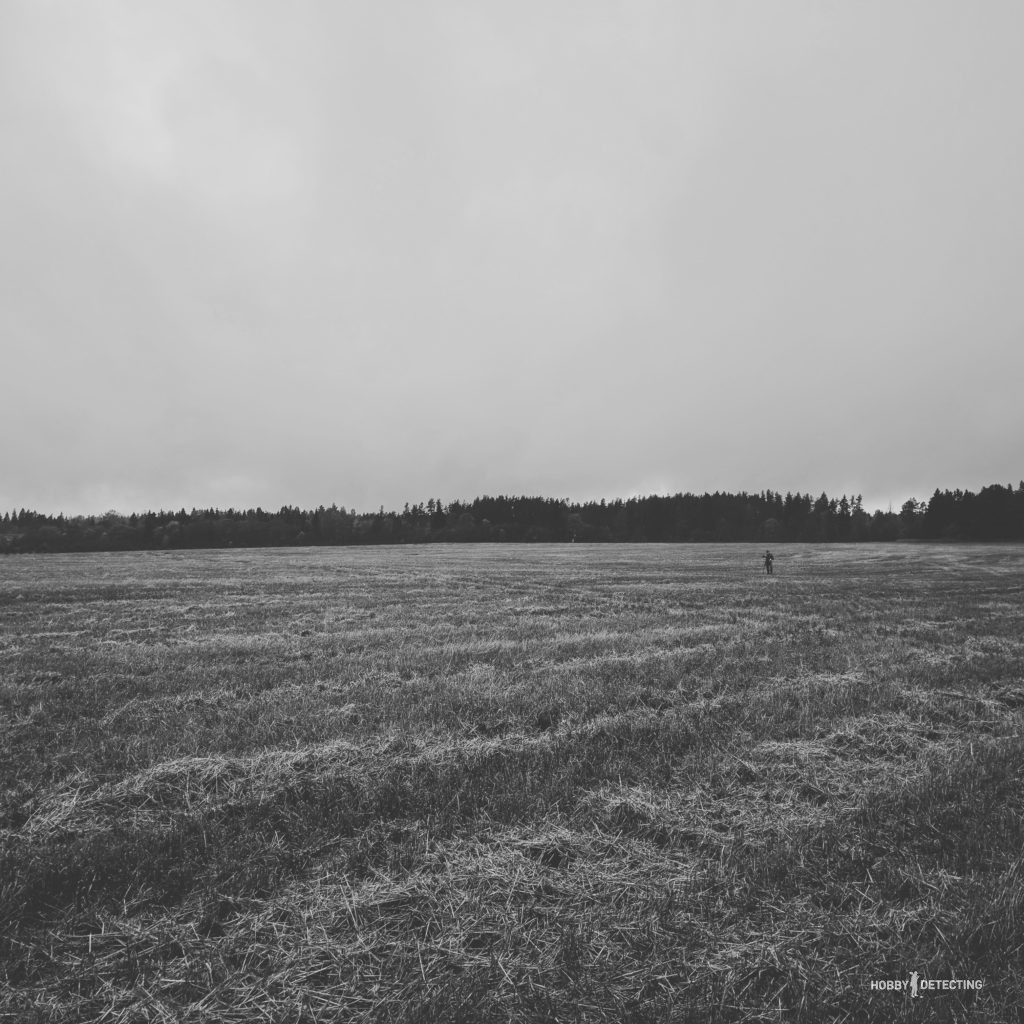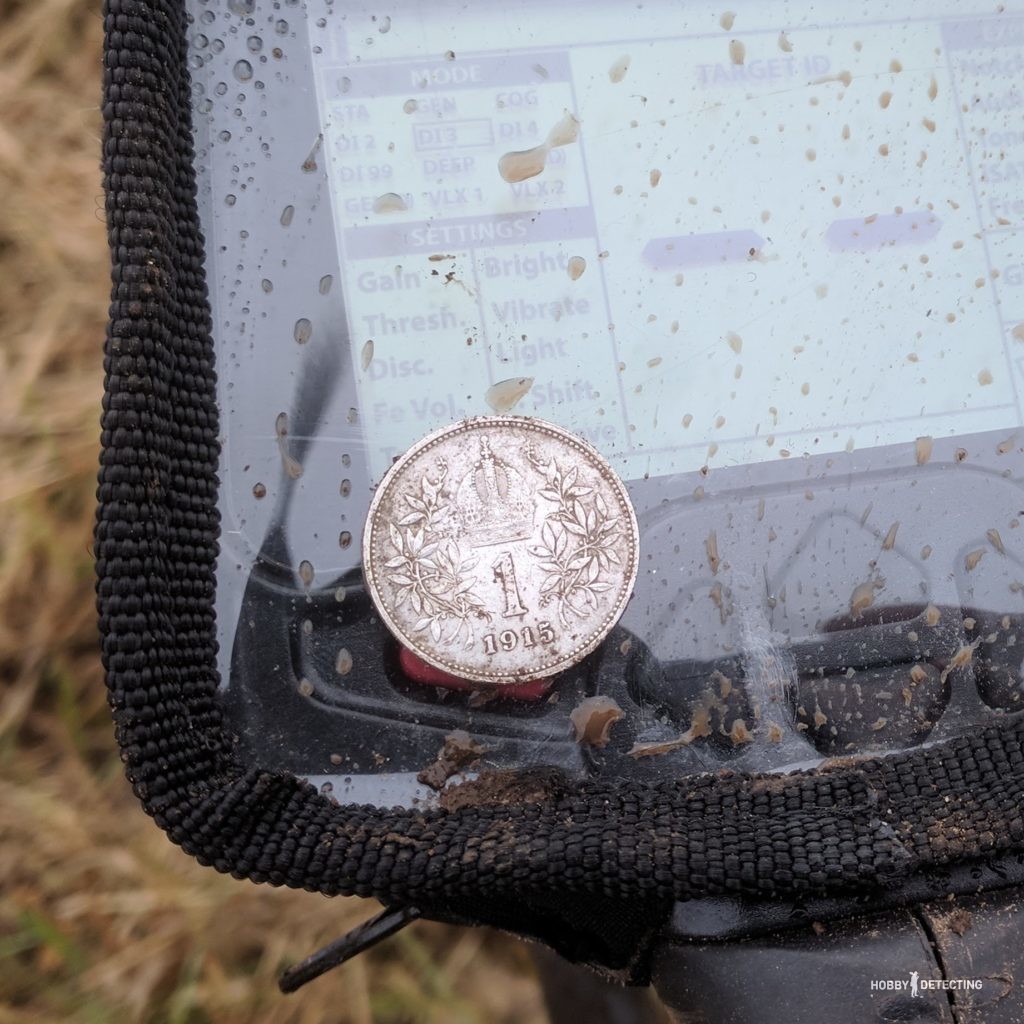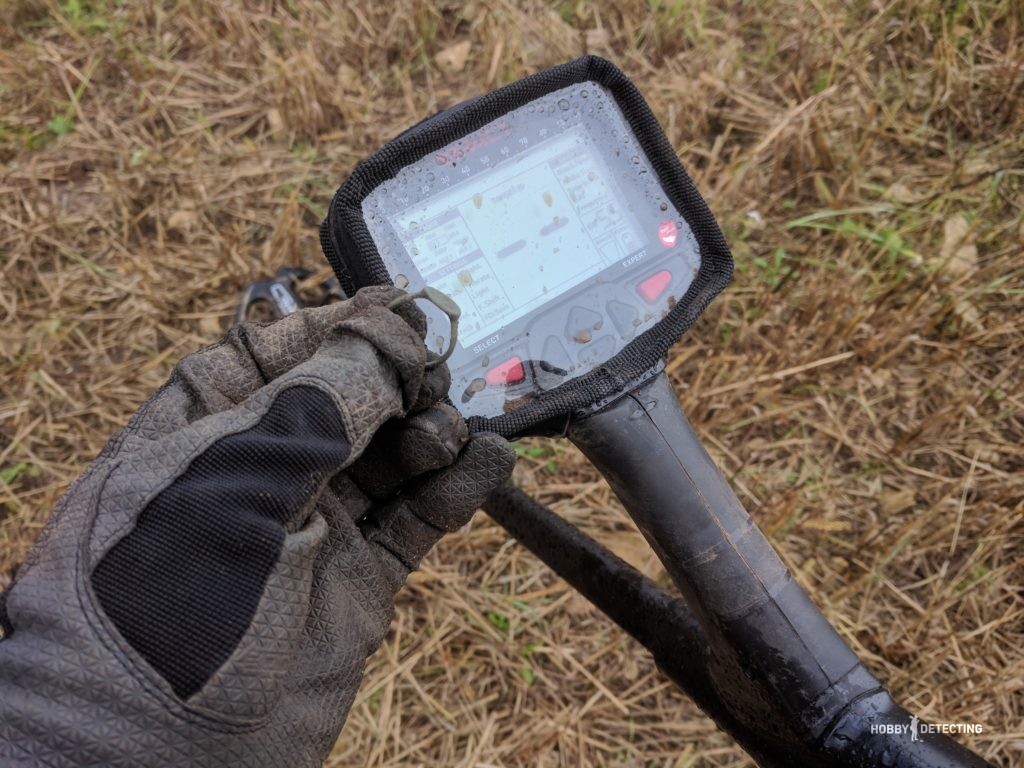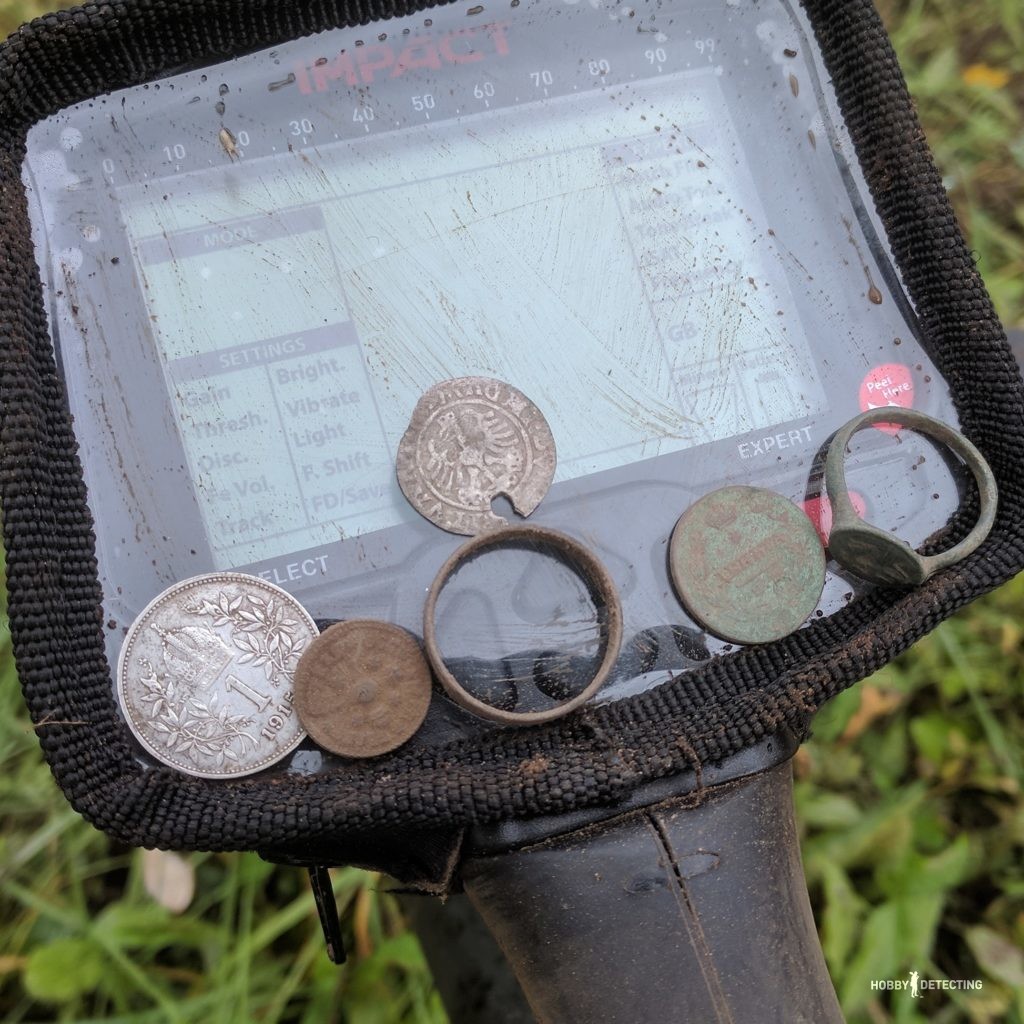An ordinary autumn coin cop
How often do you go digging? I used to go out regularly twice a week, dig a lot and plentifully, but now not with such frequency, unfortunately.
Now is the time to dig — the fields have been cleared, there is still stubble in many fields, but in general this does not bother the cop much. You can walk and find, the main thing is to either take a larger reel to wave over the stubble without much loss of depth, or a smaller reel to wave between the stubble — it’s up to you to choose. In general, go with the standard 10″-11″ coils are possible, but a little more difficult than with the above.
It seems like a normal field. Spacious and far to the horizon.

What can you find on it? Metal and various debris. But we came for coins, which means we need to find one point where all the coins are on one spot, this usually happens in the fields. If you simply walk across the field and find nothing, then this is not an indication that there are no coins there. You have to walk and look, and if you find such a spot with a concentration of coins and various finds, then you will raise a good harvest for your collection. The same thing happened with us.
My friend and I ran across the field for three hours. We were looking for just such a place. I analyzed the old map in advance and had a rough idea in which direction I should move and, lo and behold, finds began to appear with a frequency of several minutes.
At first, an ordinary peasant copper wedding ring came out. If this is some other ring and you are an expert on rings, then correct me.

Finds such as buttons and rings, pieces of clothing and equipment show that people often spent time and engaged in some kind of activity in this place. But was there a road here, or an old settlement — Such conclusions can be drawn based on several signs, but I’ll talk about this in another post.
Then a surprise happened. Five minutes after finding the ring, my device, a brand new Nokta Impact, showed a stable color signal, VDI at 87-88, and there was such a signal from all sides, no matter how I waved the coil. As if I had already mastered the device enough to understand what lies and is under the coil, I was surprised — 87 and 88 are almost never seen here; this is some kind of unusual and interesting signal. Naturally, such stable signals need to be dug up! And here is the result:

Austrian coin — 1 crown 1915! How she ended up in our fields? The front with Austria-Hungary during the First World War is more than 1500 km from this place. Apparently there was someone’s trophy that was lost. Let’s go dig further — there should be more coins in this place!
I walked around a bit and pulled out some money from 1813, from the time of the All-Russian Emperor Alexander the First. I often come across money from early periods, just like you, I think, but money from the time of Alexander the First is always an interesting and rather rare find in the fields.
After the money, almost on the surface, I discovered a ring. And in a heap of stubble and fallen rye. The ring was not visible with the eyes, but the device showed a strong signal and it was clear that it was something large and lying on the surface. I took out a pinpointer and found my interesting find in the pile with my pens — ring «Fierce Beast», Novgorod, XV century.

Go crazy — This ring is over 500 years old! The Fierce Beast is most often a lion, such rings were worn by warriors as a symbol of courage and courage, power, fearlessness, and a similar ring could be used to seal a letter, for example.

Good digging spot = good finds even with the cheapest metal detector. But with Nokta Impact, I at least understood which goals were of interest to me and which were not. The device responded perfectly to any metal in the ground and made it clear, thanks to the presence of good sound identification of the target and the presence of a numerical identifier, that in the ground, for example, there was a plug or large rusty iron. Read the blog Hobby Detecting — http://hobby-detecting.ru/The same thing happened with the ring — The Fierce Beast was found with a VDI of 42-43, stable on all sides, the sound was also clear and understandable, and I only had one question — what kind of interesting thing is lying under the coil? The decision to dig and search was justified, naturally.  A short break after the next find was dug up. A little about the device — Nokta Impact is just a new device for 2017. I’ve been going with him for three months now and to be honest, I’m very pleased. Takes deep, separates targets well even in the ground — I have already had to test it in different fields and finds. Three frequencies, many settings, but the settings are not as complicated as those of the Deus XP; for example, even a beginner can master the device. Usually I go in the DI2 mode (two-tone discrimination), but since there was a lot of different metal debris in this field, and touching the stubble with the coil (sometimes quite strong from the swing of the coil) sometimes produced small phantoms, then after ten minutes of searching I switched to the DI3 & #8212; three-tone discrimination. The mode is good, it allows you to immediately understand that a good and colorful object has fallen under the coil, on which we then concentrate our attention, call it up and dig it up.
A short break after the next find was dug up. A little about the device — Nokta Impact is just a new device for 2017. I’ve been going with him for three months now and to be honest, I’m very pleased. Takes deep, separates targets well even in the ground — I have already had to test it in different fields and finds. Three frequencies, many settings, but the settings are not as complicated as those of the Deus XP; for example, even a beginner can master the device. Usually I go in the DI2 mode (two-tone discrimination), but since there was a lot of different metal debris in this field, and touching the stubble with the coil (sometimes quite strong from the swing of the coil) sometimes produced small phantoms, then after ten minutes of searching I switched to the DI3 & #8212; three-tone discrimination. The mode is good, it allows you to immediately understand that a good and colorful object has fallen under the coil, on which we then concentrate our attention, call it up and dig it up.
Even if the depth of the DI3 mode is not as great as that of the VLX, Gen, Deep or even DI2 modes, we will come to knock out this field again when there is no stubble and it will be possible to dig thoughtfully, but for reconnaissance mode DI3 is very suitable. It was possible to go with full polyphony, but I preferred to dig with DI3, yet even if the VDI of non-ferrous metal is good in numbers, then by the sound (the quack at the beginning and the end of the swing of the coil over the object) it was clear that the object was metal garbage. Once again about depth — coin «MONEY» 1813 I picked up from a depth of about 25 cm, about the bayonet of my Black Ada Gladius shovel.
 And then it was even more interesting — I got an unstable and incomprehensible signal. The VDI jumps, but it doesn’t jump like it does on junk metal, but a little in a special way. I decided to dig. As a result — this coin, half penny of Alexander Jagiellonczyk, Grand Duke of Lithuania, minted around 1501. Yes, the coin is cheap, but interesting and will go great in a collection of medieval silver. Why did the VDI jump and raise doubts? It’s simple — After I dug up the coin, I reached into the pin hole again and found a small forged nail. It turns out that the nail masked the coin a little, but I dug it out anyway. Now it is difficult to say whether the nail was on the coin or under it, but one thing is clear — it went under the reel along with the coin.
And then it was even more interesting — I got an unstable and incomprehensible signal. The VDI jumps, but it doesn’t jump like it does on junk metal, but a little in a special way. I decided to dig. As a result — this coin, half penny of Alexander Jagiellonczyk, Grand Duke of Lithuania, minted around 1501. Yes, the coin is cheap, but interesting and will go great in a collection of medieval silver. Why did the VDI jump and raise doubts? It’s simple — After I dug up the coin, I reached into the pin hole again and found a small forged nail. It turns out that the nail masked the coin a little, but I dug it out anyway. Now it is difficult to say whether the nail was on the coin or under it, but one thing is clear — it went under the reel along with the coin.

I will write a separate post about this coin, because I dug up an interesting story about this character and his life path. Read our Hobby Detecting blog! 🙂
 This was the small result of a three-hour dig in a huge field, and even covered with stubble! I was pleased with the coins and rings, quite good. A lot of garbage was also dug up, because in my mind, in such places, rich in finds and history, you need to dig for all the signals, which is what I tried to do even though Nokta Impact perfectly shows me whether the garbage is under the reel or not. < /p>
This was the small result of a three-hour dig in a huge field, and even covered with stubble! I was pleased with the coins and rings, quite good. A lot of garbage was also dug up, because in my mind, in such places, rich in finds and history, you need to dig for all the signals, which is what I tried to do even though Nokta Impact perfectly shows me whether the garbage is under the reel or not. < /p>
Metal detector cases helped — During the digging it rained periodically and without covers the device could easily be broken. Still, take care of your search equipment; there are very few waterproof metal detectors on the market now, but you want to dig often and without waiting for the device to be returned from repair.
No fluff under the reel!
